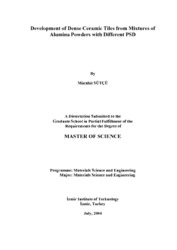Please use this identifier to cite or link to this item:
https://hdl.handle.net/11147/3362Full metadata record
| DC Field | Value | Language |
|---|---|---|
| dc.contributor.advisor | Akkurt, Sedat | - |
| dc.contributor.author | Sütçü, Mücahit | - |
| dc.date.accessioned | 2014-07-22T13:51:23Z | - |
| dc.date.available | 2014-07-22T13:51:23Z | - |
| dc.date.issued | 2004 | - |
| dc.identifier.uri | http://hdl.handle.net/11147/3362 | - |
| dc.description | Thesis (Master)--Izmir Institute of Technology, Materials Science and Engineering, Izmir, 2004 | en_US |
| dc.description | Includes bibliographical references (leaves: 64-66) | en_US |
| dc.description | Text in English; Abstract: Turkish and English | en_US |
| dc.description | xii, 66 leaves | en_US |
| dc.description.abstract | In Turkey, domestic alumina powders are generally used as an intermediate product in metallic aluminum production. Recently, its usage as a raw material for technical applications in ceramic industry has gained importance. The properties of domestic powders must be improved in order to be used in technical ceramic applications. Because these powders have coarse particle size with a high amount of sodium oxide as well as incomplete transformation to stable form. Therefore, sodium oxide that has been physically and chemically bound to aluminum oxide during Bayer process must be removed. In this study, sodium oxide (Na2O) content of the domestic powders was decreased to desirable levels (<0.15% Na2O) by hot washing treatments. These powders were calcined to transform into stable alpha form. X-Ray Diffraction (XRD) was preformed to analyze the calcined and as-received powders. Chemical analyses of the powders were done using Atomic Absorption Spectrometry (AAS) and Inductively Coupled Plasma-Atomic Emission Spectrometry (ICP-AES). Domestic powders were ground. Scanning Electron Microscopy (SEM) was performed to analyze the morphology and particle size distributions of as-received and ground powders. Particle size distributions (PSD) were plotted using lineal intercept method. In this study, it was aimed to provide maximum packing by blending the powders in different combinations (binary and ternary powder blends). In addition to this, dense ceramic tiles were produced by blending different proportions of the powders that provide maximum packing. In this study, the improved domestic (coarse size-SKA and medium size-SEA) and superground (Alcoa CT3000SG) alumina powders with three different particle size distributions were used. The packing of binary (SEA-CT3000SG) and ternary (SKA-SEA-CT3000SG) blends were predicted by using the softwares, MXENTRY® and MIX10®. These softwares utilized the Dinger-Funk (DF) equation for predictions of packing. Prepared blends were uniaxially dry-pressed and sintered. Archimedes method was used to measure the density and porosity of the pellets. All results showed that the blend contained 100% superground alumina powders achieved almost full density (98%) at 1550C. The binary and ternary blends that contained a relatively higher proportion of fine alumina powders provided higher fired densities. In binary blends, if the proportion of SEA was up to 50%, porosity values of these blends increased. Also the effects of additives such as TiO2 and MnO2 on densification and mechanical properties of pellets were investigated. The additives provided higher fired densities between 91 and 99%. Vickers hardness tests were conducted to determine mechanical properties of the sintered pellets. The samples that contained relatively higher proportions of fine particles provided higher hardness values in a range of 1500 and 2100 kg.mm-2. Also, microstructural characterization of the pellets was done using SEM. Finally, the tiles at desired dimensions were produced based on the blends that give the highest density and hardness values. Porosity and density measurements, microstructural and mechanical characterizations of the tiles were carried out. | en_US |
| dc.language.iso | en | en_US |
| dc.publisher | Izmir Institute of Technology | en_US |
| dc.rights | info:eu-repo/semantics/openAccess | en_US |
| dc.subject.lcc | HD9600.C47 .S96 2004 | en |
| dc.subject.lcsh | Ceramic powders industry | en |
| dc.subject.lcsh | Ceramic powders | en |
| dc.subject.lcsh | Ceramics | en |
| dc.title | Development of Dense Ceramic Tiles From Mixtures of Alumina Powders With Different Psd | en_US |
| dc.type | Master Thesis | en_US |
| dc.institutionauthor | Sütçü, Mücahit | - |
| dc.department | Thesis (Master)--İzmir Institute of Technology, Materials Science and Engineering | en_US |
| dc.relation.publicationcategory | Tez | en_US |
| dc.identifier.wosquality | N/A | - |
| dc.identifier.scopusquality | N/A | - |
| item.grantfulltext | open | - |
| item.openairetype | Master Thesis | - |
| item.cerifentitytype | Publications | - |
| item.fulltext | With Fulltext | - |
| item.languageiso639-1 | en | - |
| item.openairecristype | http://purl.org/coar/resource_type/c_18cf | - |
| Appears in Collections: | Master Degree / Yüksek Lisans Tezleri | |
Files in This Item:
| File | Description | Size | Format | |
|---|---|---|---|---|
| T000462.pdf | MasterThesis | 2.94 MB | Adobe PDF |  View/Open |
CORE Recommender
Items in GCRIS Repository are protected by copyright, with all rights reserved, unless otherwise indicated.